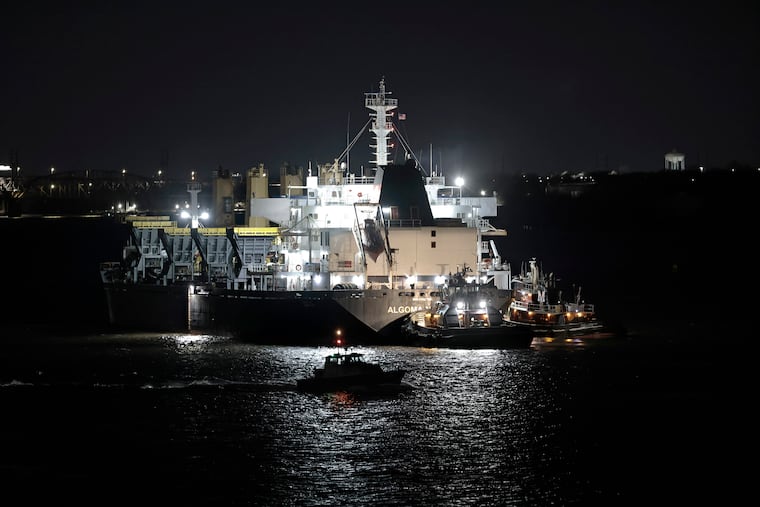A massive cargo ship is stuck in the Delaware River, the coast guard says
The Algoma Verity was carrying salt.

Crews are working to dislodge a cargo ship that became stuck in the Delaware River on Wednesday night while hauling salt, the U.S. Coast Guard said.
The Coast Guard was called to the scene around 6:30 p.m. Wednesday when the Algoma Verity — a 623-foot-long bulk carrier — ran aground just north of the Ben Franklin Bridge between Penn Treaty Park and Petty’s Island. The vessel left port in Philadelphia around 5:30 p.m. and was headed to Fairless Hills, Bucks County, according to the website Marine Traffic.
Dislodging efforts were still ongoing as of Thursday night, Coast Guard spokesperson Matthew West confirmed. There was no estimate for when the ship would be removed and taken to a nearby terminal, West said. Vessel traffic is currently restricted between the Ben Franklin Bridge and the Tioga Marine terminal as a mix of Coast Guard crews and private tugboats work to move the ship.
The cause of the incident was under investigation, the spokesperson said, but the Coast Guard has received no reports of injuries or pollution in the water.
“There’s not really any sort of standard” for how long dislodging a stuck cargo ship can take, West said, since plans often change with the tides, weather conditions, and the availability of personnel, among other factors.
Built in 2000, the Algoma Verity can hold up to 47,404 metric tons of cargo and has over 2.1 million cubic feet of storage space, according to an info sheet from the Algoma Central Corp., the vessel’s owner. Currently, the ship is flying under the flag of the Bahamas. It was carrying about 45,000 tons of solar salt — which is commonly used for water softening — at the time it ran aground.
Philadelphia has been dealing with persistently strong winds since the start of the week, with gusts reaching up to 35 mph Wednesday. These winds can result in “abnormally low water levels” as much as 2.5 feet below normal in the Delaware River, according to the National Weather Service. Low water levels can make navigation more difficult, the weather service said.
The Coast Guard did not have data immediately available regarding how often massive cargo ships actually get stuck in the Delaware River. Ships typically run aground when the draft of a boat (the distance between the deepest point of a vessel and its waterline) and the depth of the water are about equal, West said, though what causes that to happen can vary. Sometimes, it has to do with the weather or changes in the topography of a waterway’s floor. Other times, it could do with bad fuel, mechanical failures, or miscalculating the depth of the water.
“It’s comparable to saying, ‘What causes cars to crash?’” West said. “There are a million different reasons.”